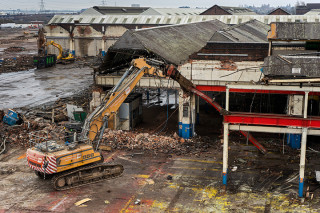Nottingham-based Total Reclaims Demolition (TRD) is clearing the former home of train-maker Alstom at Washwood Heath in Birmingham to make way for a new HS2 train maintenance depot.
The 11-hectare site, at the heart of the HS2 network, is part of British railway history and has been producing rolling stock for most of the past 100 years.
In 2005, Alstom closed the factory after a contract with Virgin for Alstom’s Italian-style Pendolino trains came to an end. Now main contractor Laing O’Rourke/Murphy joint venture (LMJV) is redeveloping the site as part of Phase 1 of HS2.
TRD is clearing the complex of old buildings and structures, producing an estimated 413,000 tonnes of demolition material – most of which LMJV is hoping to reuse on site.
Clearing the site entails the removal and sorting of a wide range of waste materials including thousands of tonnes of concrete and brick, as well as metals including steel, aluminium and copper plus miscellaneous plastic, glass, cement and insulation products. There is also a large quantity of timber.
As its name suggests, Total Reclaims Demolition is expected to reclaim and recycle as much of the material arising from the demolition works as possible.
“We are achieving a minimum of 95% reuse/recycle of materials from demolition,” says Jeremy De Souza, head of communications for LMJV. “Everything has some type of recycle capacity and is sent for recycling having, in most instances, been processed and separated on site.”
All aggregate-based materials are crushed to 6F5 specification (75mm down to dust) and left on site for use in ground remediation, soil improvement and construction of haul roads by the main works contractor.
The TRD team has also reclaimed some plywood and used it to make planters, boot cleaners, wall mounted clipboards, temporary fencing and lockers for use on the site or on other TRD sites. “We are also working with Community Wood Waste as our nominated wood waste contractor for clean wood and railway sleepers,” says De Souza.
Demolition is a top-down process and most of the buildings at Washwood Heath are low-rise, many of them steel-framed. Excavators fitted with shears, crushers and breakers are used to remove roof sheeting before cutting steel trusses, stripping off wall cladding and then cutting off and removing the supporting columns. Column stubs left by the shears are later burnt off using oxy-acetylene cutting equipment.
Although most of the demolition work has been relatively simple, particular care was needed to identify and locate several subterranean voids on the site.
“There are tunnels and basements under six site units which require different methodology and larger plant than 95% of the site,” says De Souza.
“The specialist demolition machines used on site are heavy and so planning for the work on top of the tunnels and basement needed consideration for the phasing and logistics,” he says. Detailed site investigation and geotechnical surveys ensured that there were no unexpected voids into which heavy items of plant could fall.
Mike Lyons, HS2’s programme director for Phase 1 in the Midlands comments: “As we prepare for the construction of HS2, there is a huge amount of work going on at sites in the Midlands, including land clearance, habitat creation, tree planting, demolitions, archaeology, road improvement works and utility diversions.
“We currently have 62 live sites across the whole Phase 1 route, servicing over 250 work locations.

According to Lyons, more than 7,000 people are already employed on phase one of HS2 and over 300 companies in the Midlands are already working on the project.
Washwood Heath Demolition
Materials extracted to date:
Material Quantity (tonnes)
Bricks 8,000
Floor coverings 5
Metal 4,000
Mixed waste 300
Plasterboard 30
Plastic
(excl. packaging waste) 20
Timber 1,500
This article was first published in the April 2019 issue of The Construction Index magazine
UK readers can have their own copy of the magazine, in real paper, posted through their letterbox each month by taking out an annual subscription for just £50 a year. Click for details.
Got a story? Email news@theconstructionindex.co.uk



